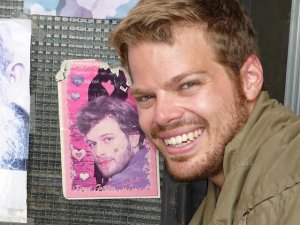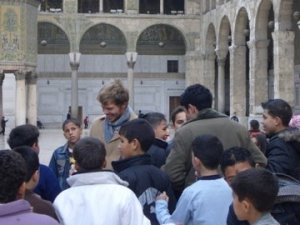I was recently cajoled into taking a practice LSAT with an aspiring-lawyer friend of mine. The LSAT is broken into three sections that are designed to test your ability to draw logical inferences from problem sets. The three sections are: Reading Comprehension, Logic Games, and Logical Reasoning. Many of the questions ask you to find the fault in a specific argument, and as I am an expert at finding fault, I did remarkably well on the test.
Let me assure you now that I have absolutely no intention of becoming a lawyer. The test simply fit into a larger theme of self-testing that I have discovered in my life in Jordan. When you have a lot of free time on your hands, and spend most of your time sitting in coffee shops avoiding work, thinking about your untapped potential becomes very important.
Previously this kind of daydreaming would have remained in the realm of fiction, but recently it has begun to solidify into a series of achievable goals and actions. Included in these is long distance running. I wrote earlier on the blog about the Dead2Red relay, and the half marathon that the race inspired me to run. These were the first two goals that I set in my new hobby of running, and I have completed both of them successfully.
I finished the half-marathon in just five minutes over two hours, not a spectacular time, but respectable. I have two friends who ran the whole marathon and did acquire spectacular times. Maya ran the race in three hours and twenty-eight minutes, taking second place in the women’s category, and Dennis came in at three hours and fifty minutes. Needless to say they are real runners.
After the race none of us could walk properly. I think it took Maya a full five days to recover a steady gait and Dennis spent the first thirty minutes after crossing the finish line on the verge of sickness. My feet, when taken out of my running shoes, were torn and bloody and have only just now healed to the point where I can run again (in new shoes).
Long distance running, it seems, requires more than just leg muscles. It is a full body workout. Keeping your arms pumping for over two hours takes a lot of effort, and the constant expansion and contraction of your abdominals wreaks havoc on your innards. By the time you are done with the race you have to lie down for thirty minutes while you allow your kidneys to realign and your stomach to slip away from your spleen. I won’t elaborate on what this process does to your bowels, but suffice it to say that it is unpleasant.
Besides the physical exertion of the race, there are the often-sited mental challenges of keeping your body moving despite all reason. Before a race everybody is nervous. Nervousness often results in an urgent need to pee, and the moment our busses stopped at the starting point a wave of men spread out from the road and faced into the desert and away from the wind. Imagine throwing a rock into a milling circle of ants and watching the effects spread out in concentric rings.
Once the race begins the nervousness dies down, but quickly the mind begins to wander. What do you think about while running? I was thinking about how I shouldn’t have eaten that oatmeal before the race. As you continue to run the reasons for running begin to cycle through your head. There aren’t very many, so this is a fairly quick and repetitive process. Eventually you settle on a new reason—I’m going to beat that woman ahead of me.
In my case, that woman is invariably a middle-aged mother of four, but who’s counting? As I caught up to her in the last half of the race we struck up a conversation. She is a Canadian national living with her husband and children in Kuwait. I am an American living in Amman on a government grant. This is all conversation that I would typically despise in any normal situation, but I suppose exchanging one tedium for another is an expectable response to…tedium.
I passed her as we hit the hills in the last leg of the race. The Dead Sea Marathon is deceptive in that way, it’s all downhill until the last seven kilometers where the elevation changes course. I recently retraced the route on a bicycle and was surprised at how gradual the ascent was, not at all how I remembered it. As I recall this stint in the race was a grueling uphill climb where I was ready to explode my various annoyances at the slightest prompt. I’m fairly sure this was a common experience judging by the one young lady who kept shouting at people in either Arabic or choked and intelligible English (I’m fairly certain it was the later).
Climbing the hills became exceptionally difficult when I discovered that the finishing line was a full two kilometers beyond where I thought. As I passed the hotel where I expected salvation and cheering spectators, a single volunteer handed me a Gatorade and pointed down the road. That Gatorade was enough to keep me going. It filled me with a delicious sweetness that lent hope to the prizes and medals that would come with crossing the finish line.
After what seemed like an intolerably long time for only two kilometers, I reached the finish line. I summoned the reserved strength in my legs and sprinted the last one hundred meters. I’m not sure why. It didn’t do much for my time and at my speed it wasn’t a very impressive feat for the spectators. I think I just wanted to make sure that I depleted the last of the strength in my legs, so that I could say that I had tried my hardest.
After a Marathon there is invariably a sense of depression underlying the artificial festivities that the event organizers have put together. The depression stems from the empty place left by the accomplishment recently achieved. I think that secretly every Marathon runner wants to reach a point where he or she can’t finish the race, where they can be assured of exhausting their potential as a runner.
There’s that word again: potential. It’s not a word that I have much affection for, mostly because of the context I have most often heard it in. You’re not reaching your full potential, John. Well, if I didn’t have to walk a single time during the race, I guess that’s true. Dennis, Maya, and I will have to find another marathon to run, where I can run the entire forty-two kilometers. Now, after reading this story, you might ask, where’s the logic in that?

5:00am at the Start Line














